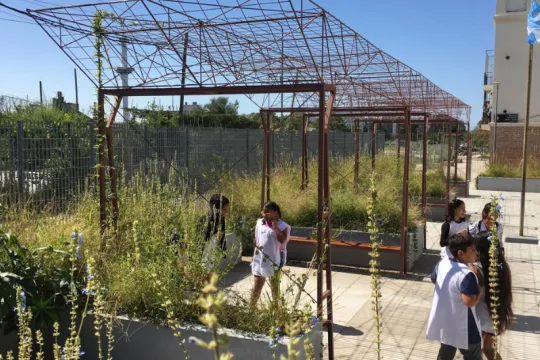
Planting day in Teresa Rodriqguez Passage, November 2022. © Florencia Almansi / TUC
In Buenos Aires, the TUC Urban Lab is working with stakeholders of a neighbourhood upgrading programme in the Villa 20 area. The city's Institute of Housing, the Instituto de Vivienda de la Ciudad (IVC), coordinates the upgrading work. Jojo Hardoy of IIED America Latina spoke with IVC's Cristian Larra about how the TUC Urban Lab has shifted his thinking on how urban planning and upgrading can integrate climate action, specifically decarbonization in low-income communities.
Can you tell us about IVC's mission and your work?
IVC carries out the housing policy of the city of Buenos Aires. I coordinate the Urban Project and Infrastructure Department, which manages the design of public space requirements in all the neighbourhoods where IVC intervenes. We work on the design of public spaces, squares, pocket parks, streets and everything related to urban planning.
To what extent did IVC consider upgrading alongside climate change before the IKI TUC project?
In the past, the urban plans implemented by IVC did not specifically address sustainability or climate change issues. Our projects considered construction design to meet thermal conditions for house walls, for example. In recent redevelopment works, we incorporated new technologies into the architecture, such as solar heating tanks. More recently, motivated by our partnership with IKI TUC, we have started working with solutions for public spaces that incorporate more detailed considerations of green city characteristics, such as larger absorbent soil surfaces, cool corridors with shade in the streets and so on. Although we always applied basic design concepts, we did not consider the wider climate change problem. Even if we reviewed the regulations, issues related to climate change were not considered in the previous municipal Urban Planning Code. The new Urban Planning Code now includes several programmes under Title 10, such as the Strategic Environmental Assessment Programme for resilient cities and environmental considerations in policies, plans and programmes.
In short, in the past, there was almost no consideration of climate change; we worked with standardized design assumptions, and the issue of climate change was not the focus of our programmes. Today I believe that the IKI TUC partnership provides us with a space where we can advise each other, exchange ideas, and enrich IVC with the creation of new teams that are better able to tackle the climate change issue in the neighbourhoods.
Why do you think climate change was not previously considered?
IVC's main objective is the creation of social housing with a focus on low-income neighbourhoods. There are always urgent needs in these neighbourhoods, and the issue of sustainability or climate change is not a priority. The residents' basic need is to access decent housing, whether it is new housing or renovation of existing housing that improves basic infrastructure and habitability. This need is always the priority in political decision-making and project execution. The entire IVC apparatus is focused on meeting this need.
Could you provide examples of how you are integrating wide-ranging climate change solutions in your urban planning practice?
There is a reality that we must be aware of: in low-income neighbourhoods, public space is very competitive, the streets are narrow, there are encroachments on pavements (enclosures, stairs, or car parks), the fronts of houses are narrow, and the uses on the ground floor are variable and changing; it is a different reality compared to formal city areas. As a result of redevelopment, with the opening up of streets and the creation of new blocks, public spaces emerge where new solutions can be applied, such as wider pavements, pocket squares, and so on. These would be like an oasis within the very compact infrastructure.
So, in contrast to older neighbourhoods, in new neighbourhoods there is a real possibility of addressing climate change at the planning stage. For example, take the case of the development of the Barrio Papa Francisco. This is a new neighbourhood where we could have integrated decarbonizing solutions. The development plans could have included spaces with more absorbent soils, flowerbeds and wider pavement planters. As part of the TUC partnership, we intervened in one of these areas by extending existing flowerbeds and building a pergola with vines. This solution could easily have been implemented from the planning stage at a minimum cost.
What else can be done to increase awareness of climate change and ensure that the goal of decarbonisation is incorporated into urban planning?
I think incorporating climate change into urban planning has progressed in line with the global agenda and growing awareness of the problems of large cities.
Fortunately, the availability of information has been growing. However, we need greater impetus from the government to incorporate climate change into their agendas and management. At IVC, this process is just starting. It is also important that professional training addresses the issues of climate. IVC and the city have training institutes where courses could incorporate information about climate change and decarbonization. We all know that this is a latent issue and that it has been gaining importance over time. However, even architecture or engineering degrees still don't include specific training on this subject.
What do you see as the needs of private companies and workers' cooperatives to get them to support the delivery of low-carbon cities?
I think that construction companies, or contractors, are a step behind. If we include sustainable design assumptions in the project specifications, the contractor will be obliged to carry out the works. It does not matter whether or not they are trained for it - they will have to get advice and subcontract specialists. Future urban projects must incorporate this new approach, or we risk continuing to design neighbourhoods as we did ten years ago. IVC has evolved in recent years with improved social housing design; we need the same evolution for public spaces. It is a constant learning process that requires training and tools to apply it in a timely manner. As for cooperatives, I think there is a need for more professional support, perhaps through a foundation or organization that can support them in developing new capacities, knowledge and tools. Let's remember that the cooperatives have a very strong social component, with intense participation from residents. If a request change emerges from cooperatives' and residents' teams, IVC will be attentive to these demands.
Looking ahead, what next steps do you think will help IVC's team and the residents of Buenos Aires informal settlements take these issues forward?
TUC's professionals are extremely creative and come up with solutions while working together with IVC's technical and social teams. It would be interesting to learn how TUC programmes are developed in other cities, such as in Mexico or Brazil, and how projects are developed and implemented in those places. I believe the Buenos Aires programme in Barrio 20 is more advanced than in the other cities, but it would be interesting to be able to share experiences and solutions that are applied in other places, to be able to analyse them and compare ideas. Looking ahead, I think that teamwork, knowledge-sharing and flexibility should be key components. The TUC team has always paid attention to IVC's work dynamics, with its participatory roundtables and the fact that transformations in neighbourhoods take time. It is essential that the projects that are presented and agreed upon with the residents are effectively carried out; they are the ones who experience the needs of the neighbourhood and – like everyone else – they want to live better lives.

